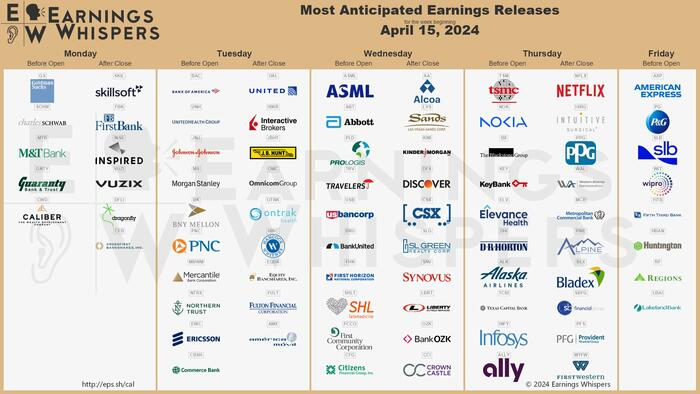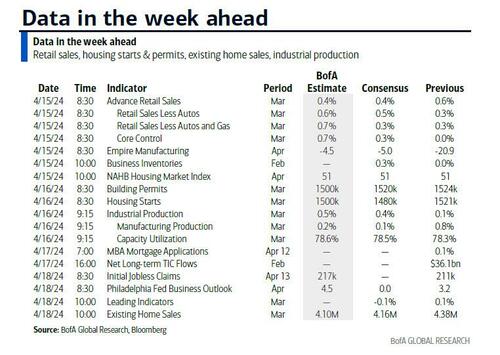


While back on Friday the market's attention was mostly on the start of earnings season, this weekend's events have quickly shift focus and looking forward, the important question now is how Israel might respond to the (scripted) war between Iran and Israel, and whether it could lead to a further escalation in the conflict (it won't, but just like Iran, Israel will likely fire off a couple of cruise missiles into the desert so as not to appear toothless and call it a day).
A meeting of Israel’s war cabinet ended on Sunday evening without a decision on how Israel would respond, and according to NBC, the war Cabinet will reconvene today. And Reuters reported that the war cabinet favored retaliation, but was divided over the response according to Israeli officials. That followed comments earlier in the day from Benny Gantz, a minister in the war cabinet, who said that Israel will “exact a price from Iran in a way and time that suits us”. And Itamar Ben-Gvir, the national security minister, called for a “crushing attack”. But in the US, reports have indicated that there is more caution about an escalation, and Axios reported that Biden had told Israeli PM Netanyahu that the US wouldn’t support an Israeli counterattack, according to a senior White House official.
Given all this, developments in the Middle East will be the main focus this week, and we know from recent experience that geopolitical tensions can impact the global economy through several channels. Most directly, the effects of higher oil prices will be felt globally, and this is coming at a time when there’s already concern about sticky inflation in several countries. That’s something that could create a dilemma for central banks, as we also found out after Russia’s invasion of Ukraine in 2022. On the one hand, there is the risk that a geopolitical shock hurts growth, bringing forward the timing of rate cuts. Indeed, markets were clearly pricing that risk on Friday, with the chance of a Fed rate cut by June moving up from 24% to 30%, although that’s since moved back to 24% this morning. But then again, if higher oil prices lead to more inflation and there are second round effects on other prices, then that could mean monetary policy has to stay in restrictive territory for longer. So the potential effects can work both ways.
Turning away from geopolitics, we’ll get the chance to hear from several policymakers this week, as numerous officials are gathering in Washington DC for the IMF-World Bank Spring Meetings. Tomorrow, we’ll get the IMF’s latest World Economic Outlook, including their forecasts for the global economy. And over the week, we’ll hear from Fed Chair Powell, ECB President Lagarde, and Bank of England Governor Bailey, among others. This week is also the last opportunity to hear from Fed speakers ahead of the next meeting, as their blackout period begins on Saturday.
Otherwise this week, earnings season will begin to ramp up before it really gets into full flow over the subsequent week. That includes releases from 41 companies in the S&P 500, along with 21 from the STOXX 600, with results from Morgan Stanley, Goldman Sachs, Bank of America, Netflix and Johnson & Johnson.
Finally on this week’s data, we’ve got the Q1 GDP release for China out tomorrow, along with their March data for retail sales and industrial production. Meanwhile, there are CPI releases for March in the UK, Japan and Canada, which will also be in focus as markets assess the timing of any monetary policy moves. Then in the US, we’ve also got some more data for March, including retail sales, housing starts, building permits, and industrial production.
Courtesy of DB, here is a day-by-day calendar of events
Monday April 15
Tuesday April 16
Wednesday April 17
Thursday April 18
Friday April 19
Finally, here is a weekly preview focusing only on the US from Goldman, which notes that the key economic data releases this week are the retail sales report on Monday and the Philly Fed manufacturing index on Thursday. There are several speaking engagements from Fed officials this week, including public appearances by Chair Powell and by Vice Chair Jefferson on Tuesday and by New York Fed President Williams on Monday, Tuesday, and Thursday.
Monday, April 15
Tuesday, April 16
Wednesday, April 17
Thursday, April 18
Friday, April 19
Source: DB, Goldman, BofA

